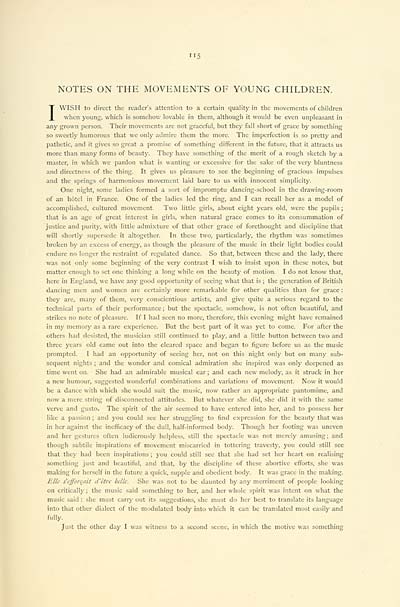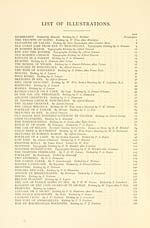Non-Fiction > Uncollected essays > Volumes 5-6, 1874-1875 - Portfolio > Volume 5
(13) Page 115 - Notes on the movements of young children
Thumbnail gallery: Grid view | List view

115
NOTES ON THE MOVEMENTS OF YOUNG CHILDREN.
I WISH to direct the reader's attention to a certain quality in the movements of children
when young, which is somehow lovable in them, although it would be even unpleasant in
any grown person. Their movements are not graceful, but they fall short of grace by something
so sweetly humorous that we only admire them the more. The imperfection is so pretty and
pathetic, and it gives so great a promise of something different in the future, that it attracts us
more than many forms of beauty. They have something of the merit of a rough sketch by a
master, in which we pardon what is wanting or excessive for the sake of the very bluntness
and directness of the thing. It gives us pleasure to see the beginning of gracious impulses
and the springs of harmonious movement laid bare to us with innocent simplicity.
One night, some ladies formed a sort of impromptu dancing-school in the drawing-room
of an hotel in France. One of the ladies led the ring, and I can recall her as a model of
accomplished, cultured movement. Two little girls, about eight years old, were the pupils ;
that is an age of great interest in girls, when natural grace comes to its consummation of
justice and purity, with little admixture of that other grace of forethought and discipline that
will shortly supersede it altogether. In these two, particularly, the rhythm was sometimes
broken by an excess of energy, as though the pleasure of the music in their light bodies could
endure no longer the restraint of regulated dance. So that, between these and the lady, there
was not only some beginning of the very contrast I wish to insist upon in these notes, but
matter enough to set one thinking a long while on the beauty of motion. I do not know that,
here in England, we have any good opportunity of seeing what that is ; the generation of British
dancing men and women are certainly more remarkable for other qualities than for grace :
they are, many of them, very conscientious artists, and give quite a serious regard to the
technical parts of their performance; but the spectacle, somehow, is not often beautiful, and
strikes no note of pleasure. If I had seen no more, therefore, this evening might have remained
in my memory as a rare experience. But the best part of it was yet to come. For after the
others had desisted, the musician still continued to play, and a little button between two and
three years old came out into the cleared space and began to figure before us as the music
prompted. I had an opportunity of seeing her, not on this night only but on many sub-
sequent nights ; and the wonder and comical admiration she inspired was only deepened as
time went on. She had an admirable musical ear ; and each new melody, as it struck in her
a new humour, suggested wonderful combinations and variations of movement. Now it would
be a dance with which she would suit the music, now rather an appropriate pantomime, and
now a mere string of disconnected attitudes. But whatever she did, she did it with the same
verve and gusto. The spirit of the air seemed to have entered into her, and to possess her
like a passion ; and you could see her struggling to find expression for the beauty that was
in her against the inefficacy of the dull, half-informed body. Though her footing was uneven
and her gestures often ludicrously helpless, still the spectacle was not merely amusing; and
though subtile inspirations of movement miscarried in tottering travesty, you could still see
that they had been inspirations ; you could still see that she had set her heart on realising
something just and beautiful, and that, by the discipline of these abortive efforts, she was
making for herself in the future a quick, supple and obedient body. It was grace in the making.
Ellc s'cjforcait d'etre belle. She was not to be daunted by any merriment of people looking
on critically ; the music said something to her, and her whole spirit was intent on what the
music said : she must carry out its suggestions, she must do her best to translate its language
into that other dialect of the modulated body into which it can be translated most easily and
fully.
Just the other day I was witness to a second scene, in which the motive was something
NOTES ON THE MOVEMENTS OF YOUNG CHILDREN.
I WISH to direct the reader's attention to a certain quality in the movements of children
when young, which is somehow lovable in them, although it would be even unpleasant in
any grown person. Their movements are not graceful, but they fall short of grace by something
so sweetly humorous that we only admire them the more. The imperfection is so pretty and
pathetic, and it gives so great a promise of something different in the future, that it attracts us
more than many forms of beauty. They have something of the merit of a rough sketch by a
master, in which we pardon what is wanting or excessive for the sake of the very bluntness
and directness of the thing. It gives us pleasure to see the beginning of gracious impulses
and the springs of harmonious movement laid bare to us with innocent simplicity.
One night, some ladies formed a sort of impromptu dancing-school in the drawing-room
of an hotel in France. One of the ladies led the ring, and I can recall her as a model of
accomplished, cultured movement. Two little girls, about eight years old, were the pupils ;
that is an age of great interest in girls, when natural grace comes to its consummation of
justice and purity, with little admixture of that other grace of forethought and discipline that
will shortly supersede it altogether. In these two, particularly, the rhythm was sometimes
broken by an excess of energy, as though the pleasure of the music in their light bodies could
endure no longer the restraint of regulated dance. So that, between these and the lady, there
was not only some beginning of the very contrast I wish to insist upon in these notes, but
matter enough to set one thinking a long while on the beauty of motion. I do not know that,
here in England, we have any good opportunity of seeing what that is ; the generation of British
dancing men and women are certainly more remarkable for other qualities than for grace :
they are, many of them, very conscientious artists, and give quite a serious regard to the
technical parts of their performance; but the spectacle, somehow, is not often beautiful, and
strikes no note of pleasure. If I had seen no more, therefore, this evening might have remained
in my memory as a rare experience. But the best part of it was yet to come. For after the
others had desisted, the musician still continued to play, and a little button between two and
three years old came out into the cleared space and began to figure before us as the music
prompted. I had an opportunity of seeing her, not on this night only but on many sub-
sequent nights ; and the wonder and comical admiration she inspired was only deepened as
time went on. She had an admirable musical ear ; and each new melody, as it struck in her
a new humour, suggested wonderful combinations and variations of movement. Now it would
be a dance with which she would suit the music, now rather an appropriate pantomime, and
now a mere string of disconnected attitudes. But whatever she did, she did it with the same
verve and gusto. The spirit of the air seemed to have entered into her, and to possess her
like a passion ; and you could see her struggling to find expression for the beauty that was
in her against the inefficacy of the dull, half-informed body. Though her footing was uneven
and her gestures often ludicrously helpless, still the spectacle was not merely amusing; and
though subtile inspirations of movement miscarried in tottering travesty, you could still see
that they had been inspirations ; you could still see that she had set her heart on realising
something just and beautiful, and that, by the discipline of these abortive efforts, she was
making for herself in the future a quick, supple and obedient body. It was grace in the making.
Ellc s'cjforcait d'etre belle. She was not to be daunted by any merriment of people looking
on critically ; the music said something to her, and her whole spirit was intent on what the
music said : she must carry out its suggestions, she must do her best to translate its language
into that other dialect of the modulated body into which it can be translated most easily and
fully.
Just the other day I was witness to a second scene, in which the motive was something
Set display mode to: Large image | Transcription
Images and transcriptions on this page, including medium image downloads, may be used under the Creative Commons Attribution 4.0 International Licence unless otherwise stated. ![]()
| Early editions of Robert Louis Stevenson > Non-Fiction > Uncollected essays > Portfolio > Volume 5 > (13) Page 115 - Notes on the movements of young children |
|---|
| Permanent URL | https://digital.nls.uk/81492810 |
|---|---|
| Description | By Robert Louis Stevenson. |
| Subject / content: |
Children (people by age group) Essays Human locomotion |
|---|---|
| Person / organisation: |
Stevenson, Robert Louis, 1850-1894 [Author] |
| Dates / events: |
1874 [Date published] |
|---|
| Form / genre: |
Written and printed matter > Periodicals |
|---|---|
| Dates / events: |
1870-1893 [Date published] |
| Places: |
Europe >
United Kingdom >
England >
Greater London >
London
(inhabited place) [Place published] |
| Subject / content: |
Art Etching (printing process) |
| Person / organisation: |
Seeley Jackson & Halliday [Publisher] Hamerton, Philip Gilbert, 1834-1894 [Editor] |
| Description | Essays and reviews from contemporary magazines and journals (some of which are republished in the collections). 'Will o' the Mill', from Volume 37 of the 'Cornhill Magazine', is a short story or fable. |
|---|
| Person / organisation: |
Stevenson, Robert Louis, 1850-1894 [Author] |
|---|



